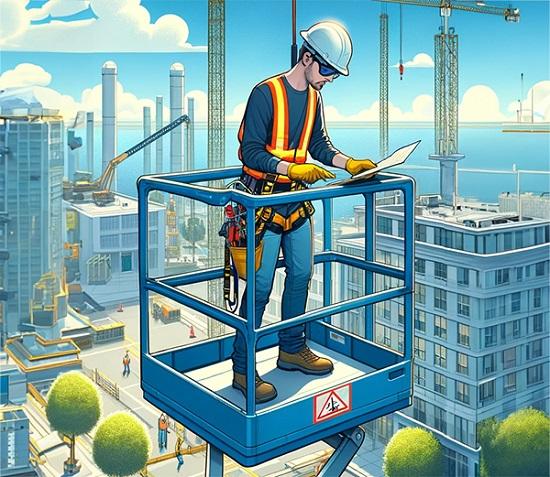Introduction
Aerial lifts are essential equipment in various industries, providing access to elevated areas for maintenance, construction, and other tasks. However, the use of aerial lifts comes with inherent risks that need to be managed effectively to ensure the safety of workers. Aerial lift safety best practices encompass a set of guidelines and procedures aimed at reducing the likelihood of accidents and injuries associated with the operation of aerial lifts in the workplace. In this comprehensive article, we will delve into the importance of aerial lift safety, the common hazards associated with aerial lifts, and the best practices for enhancing safety when operating aerial and scissor lifts in the workplace.
What is Aerial Lift Safety?
Aerial lift safety refers to the practices and protocols implemented by companies and employees to mitigate the risks associated with operating aerial lifts. Aerial lifts, including boom lifts, scissor lifts, and cherry pickers, are vehicle-mounted equipment with extended platforms used to elevate workers to reach high objects such as power lines or ceilings. The significance of aerial lift safety cannot be overstated, considering that around 26 aerial lift accidents occur annually, accounting for over 3% of construction-related deaths, according to the Center for Construction Research and Training.
Importance of Safety for Aerial Lifts
The importance of aerial lift safety cannot be understated, as it directly impacts the well-being of workers and the overall productivity and efficiency of operations. Companies that use aerial lifts are responsible for ensuring the safety of their employees and complying with regulatory standards such as those set by the Occupational Safety and Health Administration (OSHA). Failure to adhere to aerial lift safety best practices can result in severe consequences, including injuries, fatalities, legal liabilities, and damage to the company’s reputation.
Common Hazards Associated with Aerial Lifts
Aerial lifts introduce various hazards that can lead to accidents and injuries if not managed effectively. Some of the common hazards associated with aerial lifts include:
1. Fall Hazards: Accidental falls from the elevated platforms of aerial lifts are a significant risk, especially when working at heights of 60 feet or more. Factors such as high winds, unstable ground, overloading of the lift, and improper use of guardrails can contribute to fall hazards.
2. Overhead Hazards: Working around power lines and overhead obstructions poses a risk of electrocution and collisions with objects, leading to injuries or fatalities.
3. Work Area Stability Hazards: Uneven or unstable surfaces, inadequate ground support, and improper positioning of outriggers can compromise the stability of the aerial lift, increasing the risk of tip-overs and structural failures.
Aerial Lift Safety Best Practices
To enhance the safety of workers operating aerial lifts, the following best practices should be implemented and adhered to:
1. Training: Proper training is crucial for all employees working with and around aerial lifts. Training should cover the safe operation of the equipment, hazard awareness, emergency procedures, and the proper use of personal protective equipment (PPE) such as fall protection gear.
2. Inspections: Regular inspections of aerial lifts should be conducted to identify and address potential hazards, mechanical issues, and compliance with manufacturer’s requirements. Inspections should cover factors such as ground stability, overhead clearances, and the presence of others in the work area.
3. Fall Precautions: Workers should adhere to fall precautions, including closing access gates, standing firmly on the lift platform, using body harnesses with tethers, and being aware of overhead clearances and power lines.
4. Overhead Precautions: Proper precautions should be taken when working near power lines, including treating all overhead lines as energized, maintaining a safe clearance distance, and ensuring that power lines of known voltage are de-energized if required.
5. Work Area Stability Precautions: Aerial lifts should be set on level, solid surfaces or on outrigger pads to ensure stability. Brakes should be set when using outriggers, and the ground should be inspected for potential hazards.
6. Manufacturer’s Requirements: Aerial lifts should be maintained and operated in accordance with the manufacturer’s instructions and requirements to ensure safe and proper use.
7. Fall Protection: Workers operating aerial lifts should wear appropriate fall protection gear, including body harnesses with tethers, to prevent falls from elevated platforms.
8. Vigilance Around Power Lines: Workers should be vigilant when working around power lines, maintaining a safe distance and treating all power lines as energized unless confirmed otherwise.
Conclusion
In conclusion, aerial lift safety best practices are paramount for mitigating the risks associated with operating aerial and scissor lifts in the workplace. By implementing thorough training, regular inspections, and adherence to safety protocols, companies can ensure the well-being of their employees and maintain a safe working environment. A proactive approach to aerial lift safety not only prevents accidents and injuries but also fosters a culture of safety consciousness and compliance with regulatory standards. It is imperative for companies to prioritize aerial lift safety and empower their employees with the knowledge and resources to operate aerial lifts safely and effectively.










